Crescent Sustainability Initiatives
CLEAN WATER AND SANITATION (SDG 6)
The university actively promotes the availability of free drinking water for students, staff, and visitors by installing drinking water fountains throughout the campus. This initiative is essential for ensuring that all members of the university community have easy access to clean and safe drinking water.
A. MONITORING WATER QUALITY
The university ensures the quality of the drinking water through regular testing and monitoring. Parameters such as microbial content and chemical composition are regularly checked to guarantee safe drinking water for the university community. This proactive quality control is crucial for maintaining health standards and instilling confidence in the available drinking water resources.
B. DISTRIBUTION OF WATER DISPENSERS
This section summarizes the distribution of water dispensers and RO units across various buildings on campus:
Figure VI (3.3) – 1 depicts a water cooler or dispenser in a men’s hostel, specifically in A Block of the KBA Men’s Hostel in BSACIST.
- Design and Structure: The water cooler has a metallic body with multiple taps for dispensing water. It appears to be mounted on a base, possibly for stability and ease of use.
- Location: The cooler is situated in a common area, likely accessible to residents of the hostel. The surrounding environment includes tiled flooring and walls, indicating a clean and maintained space.
- Details and Conditions: Each image includes GPS coordinates, indicating the exact location of the cooler. The images are timestamped, showing they were taken on November 7, 2023, at various times throughout the day. The cooler appears to be in functional condition, although some areas show signs of wear, such as scratches or marks on the surface.
Figure VI (3.3) – 1: Free Drinking Water dispenser units at different locations
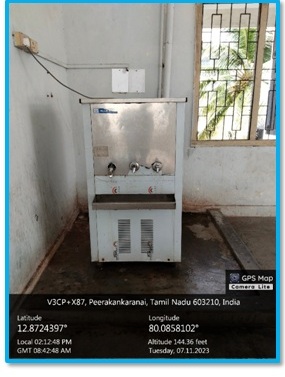
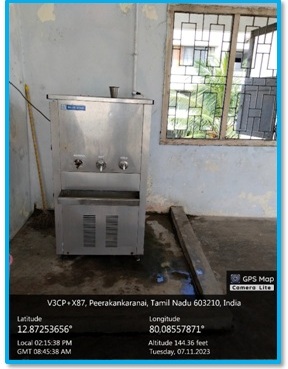
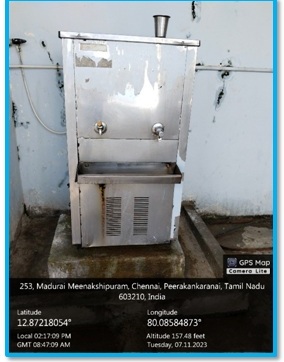
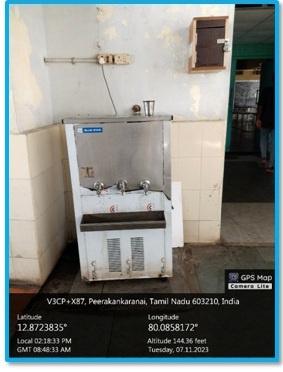
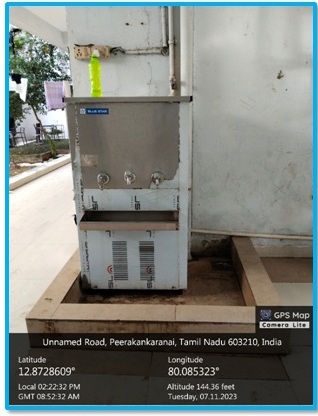
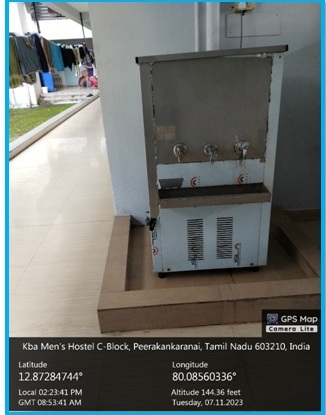
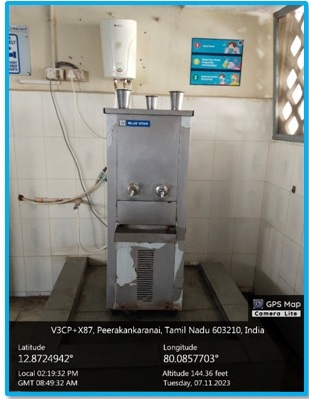
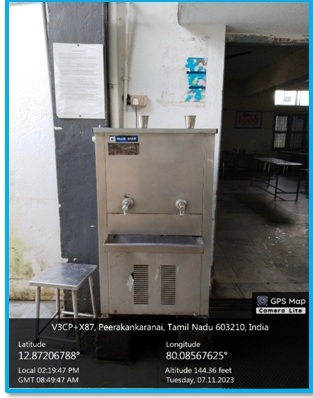
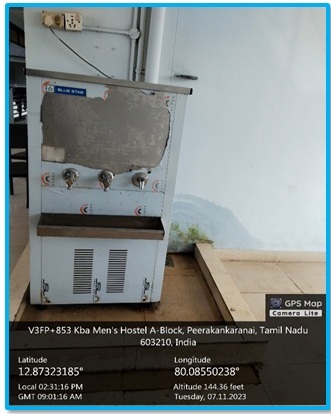
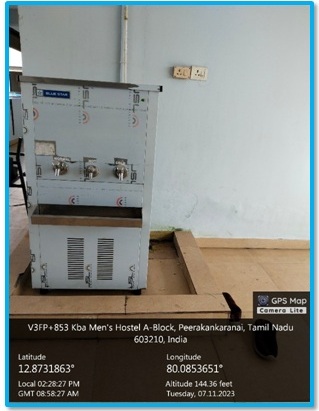
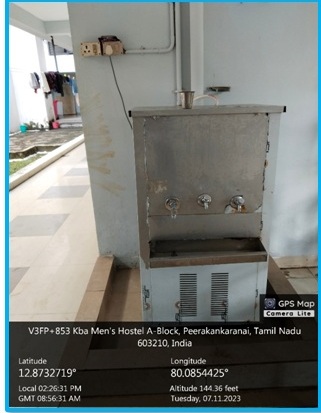
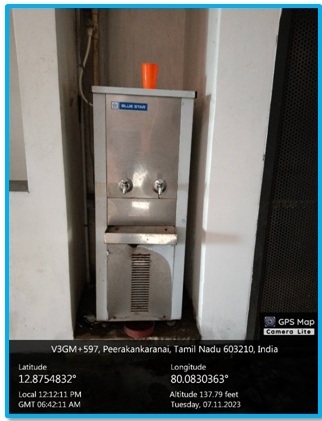
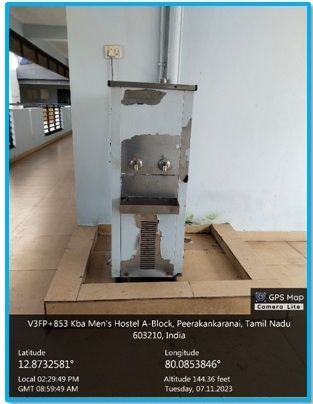
The table VI (3.3) – 1 illustrates that the university has installed a total of 64 water dispensers, each fitted with RO units, across various buildings. The total capacity of these systems amounts to 3,900 litres, ensuring that a significant volume of safe drinking water is available to the campus community.
Table VI (3.3) – 1: Building-wise water dispensers fitted with RO units Data
| S.No | Building name | Number of water Dispensers with RO Units | Total capacity (in Ltrs) |
| 1 | Electrical Science Block | 4 | 320 |
| 2 | Crescent Business School | 4 | 320 |
| 3 | Architecture Block | 5 | 200 |
| 4 | Science Block | 4 | 320 |
| 5 | Basic science block | 1 | 80 |
| 6 | Mechanical block | 4 | 180 |
| 7 | Life Science block | 8 | 340 |
| 8 | Main canteen | 3 | 180 |
| 9 | Men’s hostel A Block | 4 | 320 |
| 10 | Men’s Hostel B block | 5 | 320 |
| 11 | Men’s Hostel C block | 3 | 120 |
| 12 | Men’s Hostel D block | 5 | 320 |
| 13 | Men’s Hostel Masque | 1 | 80 |
| 14 | Ladies hostel A Block | 3 | 240 |
| 15 | Ladies hostel B Block | 3 | 240 |
| 16 | Ladies hostel C Block | 7 | 320 |
| Total | 64 | 3900 | |
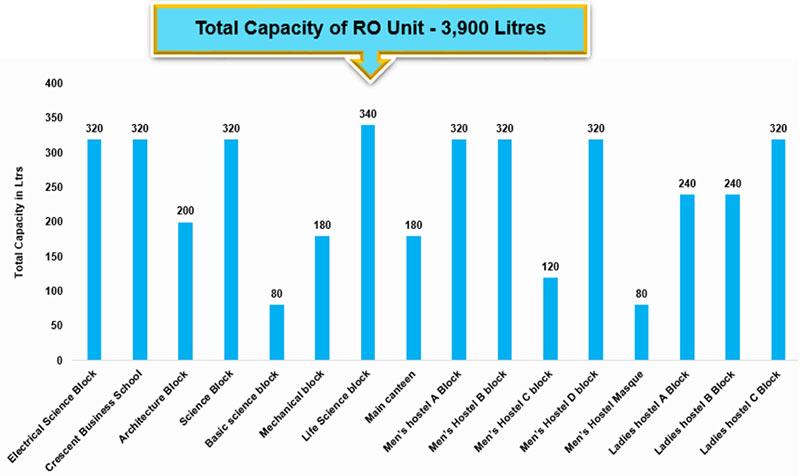
Figure VI (3.3) – 2: Building-wise water dispensers
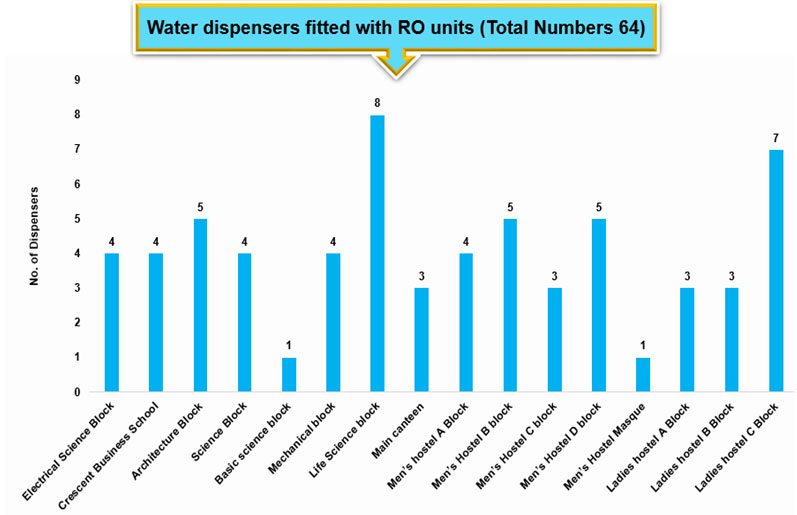
Figure VI (3.3) – 3: Building-wise RO Unit Capacity
The university places a strong emphasis on the maintenance and quality assurance of its water treatment facilities. Regular testing and maintenance of the RO systems ensure that the drinking water provided at every tap meets safety standards. This commitment to quality is essential for safeguarding the health of students, staff, and visitors.
C. RO DRINKING WATER PLANTS
The university has established a network of Reverse Osmosis (RO) plants to supply free drinking water to both the college and hostel facilities. With a total capacity of 12,500 litres per hour and 55,000 litres per day, these systems are designed to meet the hydration needs of the campus community. Water dispensers are strategically located on every floor of each building, ensuring that pure and safe drinking water is readily available at all times.
This table indicates that the total capacity of the RO plants is 12,500 litres per hour, with a total output of 55,000 litres of treated water per day. This extensive capacity ensures that the university can meet the hydration needs of its community effectively.
Table VI (3.3) – 2: RO Plant Capacity
| S. No | Location | Capacity Liters/Hr | Working Hours Per day | Qty. of Treated Water in liters |
| 1 | University Main Plant-Near to Main block | 1500 | 6 | 9000 |
| 2 | Science Block Terrace | 2000 | 5 | 10000 |
| 3 | Ladies Hostel New block Terrace | 2000 | 4 | 8000 |
| 4 | Men’s Hostel Dining Hall | 2000 | 4 | 8000 |
| 5 | Men’s Hostel Service block | 2000 | 5 | 10000 |
| 6 | Aeronautical Block terrace | 500 | 2 | 1000 |
| 7 | Life Sciences block terrace | 500 | 2 | 1000 |
| 8 | New architecture terrace | 2000 | 4 | 8000 |
| Total treated Water | 12500 | 55000 | ||
The Figure VI (3.3) – 4 depicts various Reverse Osmosis (RO) plants located in different blocks of the hostel and campus. These RO plants are essential for ensuring access to clean and safe drinking water in the respective hostel blocks and in the campus.
- Aeronautical Block RO Plant: This plant features a compact setup with multiple blue tanks, likely for water storage or filtration. It includes a control panel for monitoring and managing the purification process.
- KBA Men’s Hostel RO Plant: This image shows another RO system, possibly similar in function to the Aeronautical Block plant, designed to provide purified water for the men’s hostel.
- Architecture Block RO Plant: This plant has a more extensive arrangement with visible filtration components and a control panel. It appears to be designed for the architecture block, ensuring clean water supply for its occupants.
- TBAK Ladies Hostel New Block Terrace RO Plant: This setup is located on a terrace and includes large storage tanks. It is specifically designated for the ladies’ hostel, indicating a focus on providing safe drinking water for female residents.
Figure VI (3.3) – 4: RO Plant at different locations
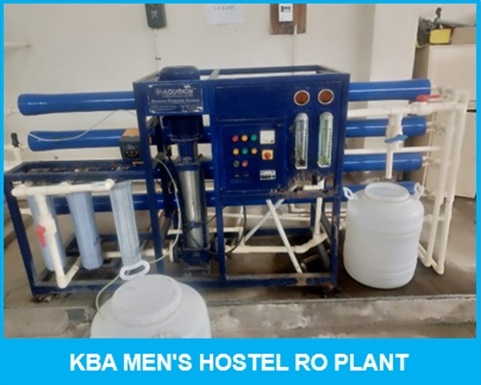
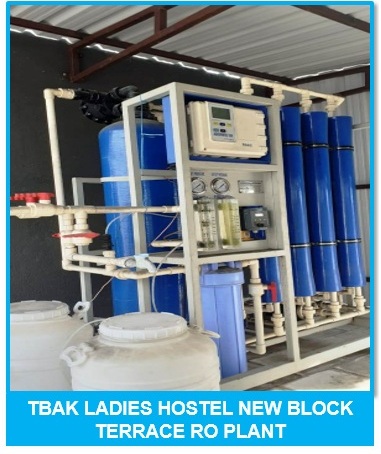
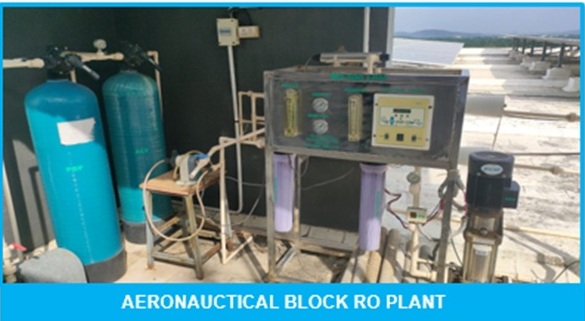
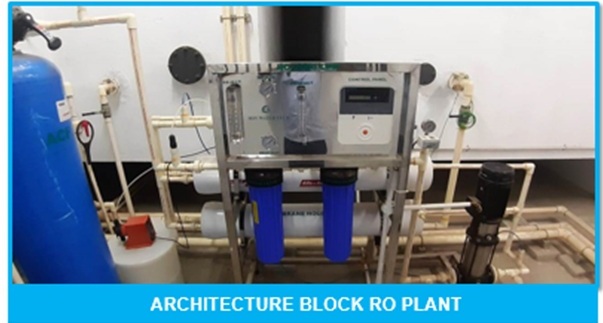
D. WATER QUALITY ANALYSIS REPORT
The Tamilnadu Test House conducted an analysis of the Reverse Osmosis (RO) water sample sourced from the B.S. Abdur Rahman Crescent Institute of Science & Technology. These detailed reports evaluate the water’s physical, chemical, and microbiological parameters to assess its quality and safety for drinking purposes. According to the analysis, various aspects of the water quality were examined, including pH levels, total dissolved solids (TDS), chemical composition, and microbiological contamination.
While a complete summary of all the results is not fully captured here, initial findings suggest that the water meets the majority of the standards set by IS 10500:2012. Various parameters were tested to ensure the water’s safety for consumption, and the results indicated compliance with permissible limits for most contaminants. The report serves as an important document for evaluating the suitability of water quality at the institution, which is critical for ensuring the health and safety of its residents. Detailed results will provide insights into any actions needed to address parameters that may exceed acceptable limits.
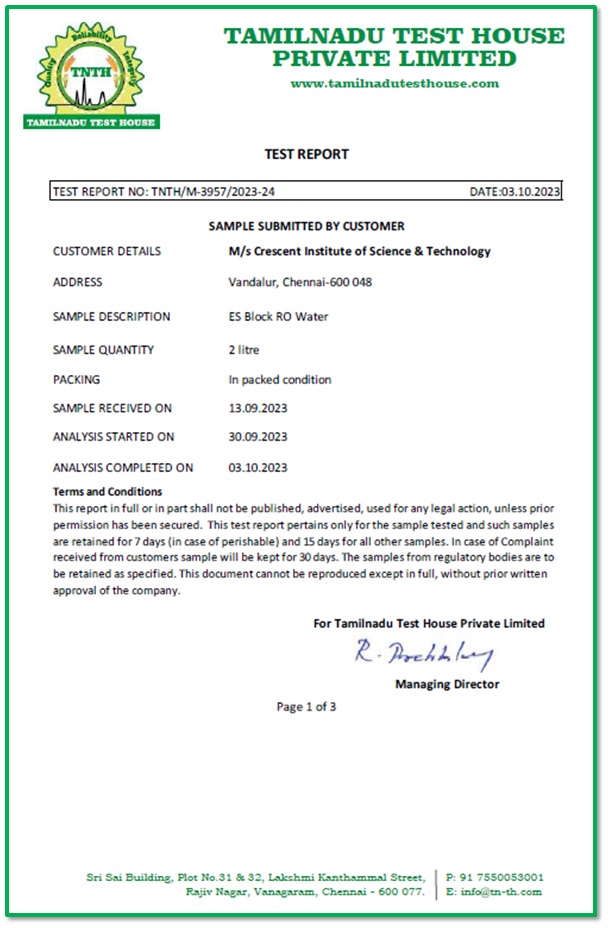
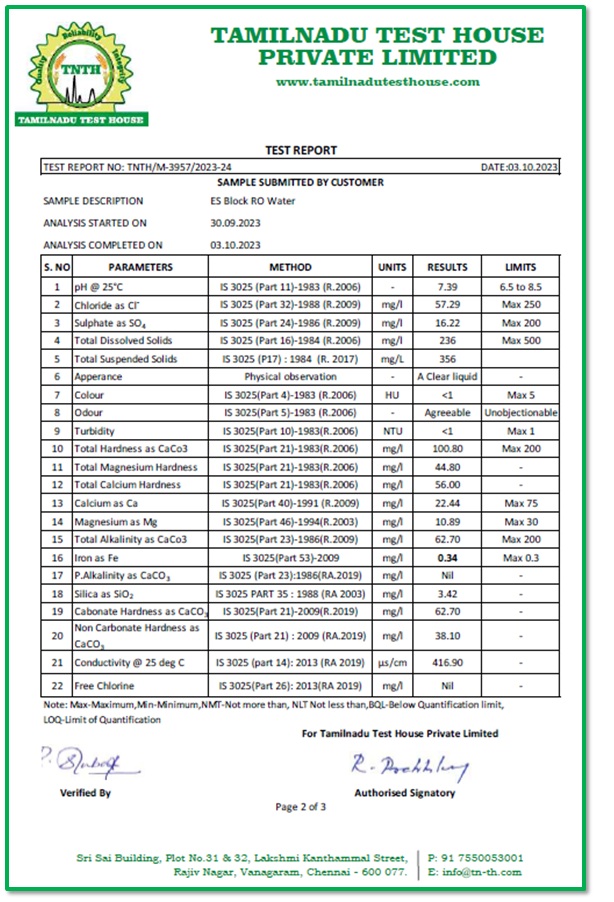
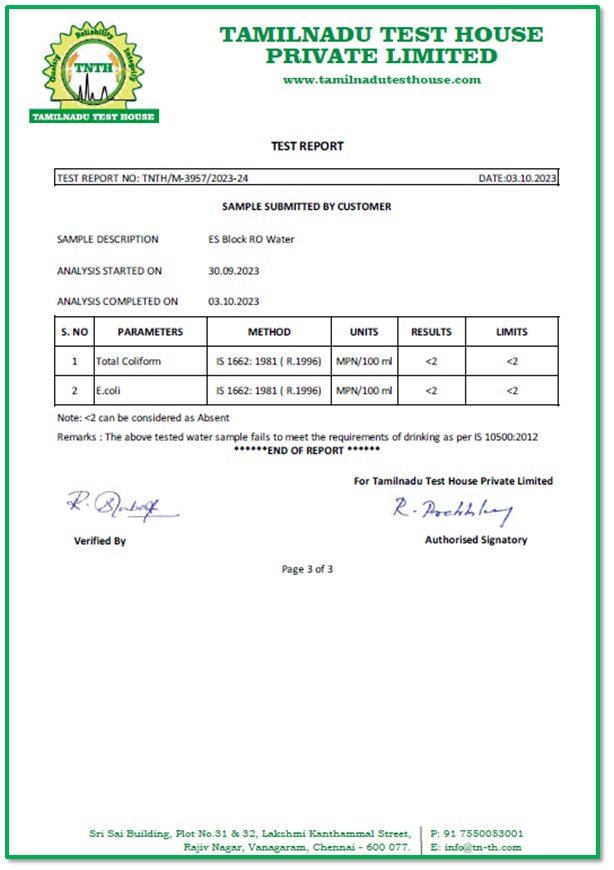
Figure VI (3.3) – 5: Water Quality Test Report from TamilNadu Test House Pvt. Ltd
(ISO Certified Company)
SUMMARY OF THE TEST REPORT
Test Report No: TNTH/M-3957/2023-24
Date: 03.10.2023
Customer: M/s Crescent Institute of Science & Technology
Sample Description: ES Block RO Water
Sample Quantity: 2 liters
Sample Received On: 13.09.2023
Analysis Period: 30.09.2023 to 03.10.2023
- Physical and Chemical Parameters:
- pH: 7.39 (within acceptable range of 6.5 to 8.5)
- Chloride: 57.29 mg/l (below max limit of 250 mg/l)
- Sulphate: 16.22 mg/l (below max limit of 200 mg/l)
- Total Dissolved Solids: 236 mg/l (below max limit of 500 mg/l)
- Total Suspended Solids: 356 mg/l (no specified limit)
- Appearance: Clear liquid
- Colour: <1 HU (max limit 5)
- Odour: Agreeable
- Turbidity: <1 NTU (max limit 1)
- Total Hardness: 100.80 mg/l (below max limit of 200 mg/l)
- Iron: 0.34 mg/l (exceeds max limit of 0.3 mg/l)
- Microbiological Analysis:
- Total Coliform: <2 MPN/100 ml (acceptable)
- E. coli: <2 MPN/100 ml (acceptable)
E. WATER QUALITY ANALYSIS REPORT
This document provides a comprehensive overview of the water quality analysis reports conducted for various water sources associated with the Crescent Institute of Science & Technology. Each report is designated by a unique test report number and covers specific water samples from different blocks and facilities within the institute.
List of Water Quality Analysis Reports
- M-3957: Electrical Science Block RO Water Analysis Report
- Analyzes the quality of reverse osmosis (RO) water sourced from the Electrical Science Block.
- M-3958: Life Science Block RO Water Analysis Report
- Evaluates the RO water quality from the Life Science Block, ensuring it meets safety standards.
- M-3959: Science Block RO Water Analysis Report
- Assesses the water quality of the RO system in the Science Block, focusing on physical and chemical parameters.
- M-3960: Architecture Block RO Water Analysis Report
- Reviews the quality of RO water supplied to the Architecture Block, highlighting any contaminants.
- M-3972: Mechanical Science Block RO Water Analysis Report
- Provides insights into the RO water quality for the Mechanical Science Block, ensuring compliance with health standards.
- M-3961: Ladies Hostel RO Water Analysis Report
- Analyzes the RO water quality specifically for the Ladies Hostel, focusing on safety for residents.
- M-3962: Men’s Hostel RO Water Analysis Report
- Evaluates the quality of RO water provided to the Men’s Hostel, ensuring it meets drinking water standards.
- M-3963: Institute Well Water Analysis Report
- Assesses the quality of water sourced from the institute’s well, focusing on natural contaminants.
- M-3964: Men’s Hostel Well Water Analysis Report
- Reviews the well water quality specifically for the Men’s Hostel, ensuring it is safe for consumption.
- M-3965: Ladies Hostel Well Water Analysis Report
- Analyzes the well water quality for the Ladies Hostel, focusing on health and safety parameters.
- M-3966: Vandalor Lorry Water Analysis Report
- Evaluates the quality of water supplied by lorries to the Vandalor area, ensuring it meets safety standards.
- M-3967: Kolapakkam Lorry Water Analysis Report
- Assesses the quality of lorry-supplied water in Kolapakkam, focusing on contaminants and safety.
- M-3968: STP Treated Water-Institute Analysis Report
- Reviews the quality of treated water from the sewage treatment plant (STP) for use within the institute.
- M-3969: STP Treated Water-Men’s Analysis Report
- Analyzes the quality of STP-treated water specifically for the Men’s Hostel, ensuring it is safe for use.
- M-3970: STP Raw Water-Institute Analysis Report
- Evaluates the raw water quality entering the STP at the institute, focusing on initial contamination levels.
- M-3971: STP Raw Water-Men’s Hostel Analysis Report
- Reviews the raw water quality for the Men’s Hostel before treatment, ensuring proper monitoring of contaminants.
REPORT LINKS
- M-3957 Electrical Science Block RO Water Analysis Report
- M-3958 Life Science Block RO Water Analysis Report
- M-3959 Science Block RO Water Analysis Report
- M-3960 Architecture Block RO Water Analysis Report
- M-3972 Mechanical Science Block RO Water Analysis Report
- M-3961 Ladies Hostel RO Water Analysis Report
- M-3962 Men’s Hostel RO Water Analysis Report
- M-3963 Institute Well Water Analysis Report
- M-3964 Men’s Hostel Well Water Analysis Report
- M-3965 Ladies Hostel Well Water Analysis Report
- M-3966 Vandalor Lorry Water Analysis Report
- M-3967 Kolapakkam Lorry Water Analysis Report
- M-3968 STP Treated Water-Institute Analysis Report
- M-3969 STP Treated Water-Men’s Analysis Report
- M-3970 STP Raw Water-Institute Analysis Report
- M-3971 STP Raw Water-Men’s Hostel Analysis Report
Water Management and Reuse Policy
Issue: 04; Revised on 2023
| Policy Created on | July 2009 |
| 1st Revision amended on | IQAC Meeting held on 27th October 2017 |
| 2nd Revision amended on | IQAC Meeting held on 31st March 2021 |
| 3rd Revision amended on | IQAC Meeting held on 16th June 2023 |
6.1 STATEMENT OF POLICY
The B.S. Abdur Rahman Crescent Institute of Science and Technology is committed to achieving the following objectives in alignment with Sustainable Development Goal 6 (SDG 6) – Clean Water and Sanitation:
- a) Ensure universal and equitable access to safe and affordable drinking water for all stakeholders.
- b) Provide adequate and equitable sanitation and hygiene for all, with special attention to the needs of women, girls, and vulnerable groups.
- c) Improve water quality by reducing pollution, eliminating dumping, and minimizing the release of hazardous chemicals and materials.
- d) Halve the proportion of untreated wastewater and substantially increase recycling and safe reuse globally.
- e) Substantially increase water-use efficiency across all sectors and ensure sustainable withdrawals and freshwater supply to address water scarcity.
- f) Implement integrated water resources management at all levels, including transboundary cooperation as appropriate.
- g) Protect and restore water-related ecosystems, including mountains, forests, wetlands, rivers, aquifers, and lakes.
- h) Expand international cooperation and capacity-building support to developing countries in water- and sanitation-related activities and programs.
- i) Support and strengthen the participation of local communities in improving water and sanitation management.
6.2 REASON FOR THIS POLICY
The policy aims to provide all stakeholders with adequate water supply, sanitation, and hygiene. It emphasises maximising the collection and treatment of sewage generated and the reuse of treated wastewater sustainably, thereby reducing dependency on freshwater resources. The policy promotes treating wastewater as an economic resource.
6.3 RESPONSIBILITIES
6.3.1 Policy Principles
- a) The campus shall provide adequate water supply and maximize water reuse by adhering to the following principles:
- Equitable access to safe and affordable drinking water for all stakeholders.
- Access to adequate sanitation and hygiene, ending open defecation, with special attention to vulnerable groups.
- Calculation of water usage per person (students, staff, and faculty) annually.
- Improving water quality by reducing pollution and increasing recycling and safe reuse.
- Utilization of recycled/treated wastewater for beneficial purposes, such as irrigation and toilet flushing.
- Implementation of integrated water resources management at all levels.
- Protection and restoration of water-related ecosystems on campus.
- Expansion of rainwater harvesting initiatives.
- Collaboration with government, NGOs, and industries in water-related activities.
- Support for student and staff participation in water management.
6.4.1 Water Reuse Policy Objectives
- Establish a comprehensive policy to maximize water reuse across the university.
- Ensure that all new buildings adhere to water-conscious building standards that facilitate water reuse.
- Implement systems for tracking and measuring water consumption and reuse.
6.4.2 Water Reuse
- Water Reuse Policy: maximise water reuse across the university.
- Water Reuse Measurement: Measure water reuse across the university.
6.5 DISSEMINATION OF POLICY
- a) Display signage promoting water use efficiency across the campus.
- b) Conduct awareness programs at regular intervals to increase water-use efficiency.
- c) Post the policy on the Institute’s website and update it as necessary.
6.6 ENFORCEMENT OF POLICY
- a) The Director (Planning & Development) and Deputy Director monitor compliance and address breaches.
- b) Awareness of the policy among students, staff, and visitors is essential.
- c) Breaches may lead to disciplinary action as per the Institute’s code of conduct.
REGISTRAR


